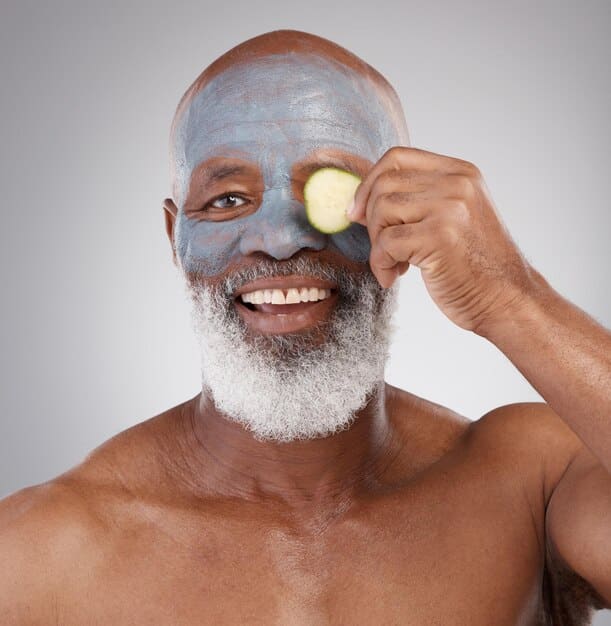Men’s Exfoliation Guide: Physical vs. Chemical Exfoliants

Achieving optimal skin health involves proper exfoliation, and men often face a unique choice between physical and chemical exfoliants, each offering distinct benefits for various skin types and concerns like ingrown hairs or uneven texture, ultimately enhancing complexion and facilitating better product absorption.
Navigating the vast world of men’s skincare can feel overwhelming, but one essential step often overlooked is exfoliation. Understanding the ultimate men’s exfoliation guide: choosing between physical and chemical exfoliants is crucial for unlocking healthier, clearer, and more youthful-looking skin. This guide aims to demystify exfoliation, helping you make informed decisions tailored to your unique skin needs.
The Essential Role of Exfoliation in Men’s Skincare
Exfoliation, the process of removing dead skin cells from the outermost layer of the skin, is a cornerstone of effective skincare routines. For men, this step is particularly vital, given common concerns such as thicker skin, larger pores, increased oil production, and the daily challenges associated with shaving. Properly exfoliating paves the way for fresh, new skin cells to emerge, leading to a brighter and more even complexion.
Beyond surface-level aesthetics, exfoliation plays a critical role in preventing a host of skin issues that men frequently encounter. Dead skin cells can accumulate, clogging pores and contributing to breakouts, blackheads, and whiteheads. Regular exfoliation helps to keep these pathways clear, allowing the skin to breathe and reducing the likelihood of these blemishes. Moreover, for men who shave, exfoliation is an indispensable tool in the fight against ingrown hairs, a common and irritating problem. By removing the dead skin that can trap hair follicles, exfoliants ensure a smoother growth path for whiskers, leading to a more comfortable and less irritating shave.
Why Men Need to Exfoliate Regularly
Understanding the specific reasons why men benefit from exfoliation can help solidify its place in a daily regimen. From combating the signs of aging to enhancing product absorption, the advantages are numerous and compelling.
* Prevents Ingrown Hairs: Shaving can cause hair to curl back into the skin. Exfoliation clears the surface, allowing hair to grow outwards.
* Reduces Breakouts and Clogged Pores: Dead skin cells, excess oil, and impurities can block pores. Regular exfoliation helps to remove these pore-clogging culprits.
* Brightens Complexion: By shedding dull, dead skin, exfoliation reveals fresher, more radiant skin underneath.
* Softens Skin and Beard: Smoother skin texture makes shaving easier and can also soften stubble or beards.
Additionally, consistent exfoliation prepares the skin to absorb other skincare products more effectively. Serums, moisturizers, and post-shave balms can penetrate deeper into freshly exfoliated skin, maximizing their benefits and delivering better results. This synergy means that investing a little time in exfoliation can significantly amplify the effects of your entire skincare arsenal.
Regular exfoliation is not just about addressing existing problems; it’s also a proactive measure to maintain skin vitality. The continuous shedding of old cells and the regeneration of new ones contribute to a youthful appearance, making the skin more resilient and vibrant over time. It’s an investment in skin health that pays dividends in both how your skin looks and feels.
Physical Exfoliants: The Abrasive Approach
Physical exfoliants, also known as mechanical exfoliants, involve using abrasive particles or tools to manually remove dead skin cells from the skin’s surface. These products typically contain small grains, beads, or natural ingredients like sugar crystals, coffee grounds, or crushed nuts. The process works by gently scrubbing the skin, physically buffing away the dull, outermost layer.
The immediate gratification of using a physical exfoliant is often appealing. You can feel the product working, and the skin often feels instantly smoother and softer to the touch. This method is particularly effective for removing surface impurities and providing a quick refresh. For men dealing with rough patches or areas prone to flakiness, a well-formulated physical exfoliant can offer noticeable improvements in texture. However, it’s crucial to select products with rounded, fine particles to avoid micro-tears in the skin. Harsh, irregularly shaped particles can cause irritation, redness, and even compromise the skin’s protective barrier, potentially leading to increased sensitivity or breakouts.
When incorporating physical exfoliants into your routine, moderation is key. Over-exfoliation can strip the skin of its natural oils, leaving it dry, irritated, and more susceptible to environmental damage. For most men, using a physical exfoliant 1-2 times per week is sufficient to reap the benefits without causing adverse effects. Pay close attention to your skin’s reaction and adjust frequency accordingly. Those with sensitive or acne-prone skin should exercise extra caution, opting for gentler formulas or considering chemical alternatives.
Proper application also plays a significant role in getting the best out of physical exfoliants. Always apply to damp skin, using gentle, circular motions. Avoid excessive pressure, especially around sensitive areas like the eyes. Rinse thoroughly with lukewarm water and follow up with a soothing moisturizer to replenish hydration and calm the skin.
Benefits of Physical Exfoliants for Men
Physical exfoliants offer a direct and tangible approach to skin renewal, providing several distinct advantages for men looking to improve their complexion.
* Instant Smoothness: Provides immediate tactile feedback, making the skin feel smoother right after use.
* Deep Cleansing: Effectively removes surface dirt, oil, and dead skin, leaving pores feeling clean and refreshed.
* Improves Shave Prep: Lifts facial hair and smooths the skin, leading to a closer and less irritating shave.
* Visible Results: Can provide a satisfying sensation of actively scrubbing away impurities.
For men with thicker, oilier skin, physical exfoliants can be particularly effective at breaking down built-up grime and promoting a clearer complexion. They are also excellent for addressing localized issues like rough elbows or knees, providing a quick fix for areas that need extra attention.
However, it’s important to differentiate between physical exfoliants and facial scrubs. While all facial scrubs are physical exfoliants, not all physical exfoliants are scrubs. Some tools, like cleansing brushes or silicone scrubbers, also fall under this category. These tools can offer a more controlled level of exfoliation without relying on abrasive particles, making them a suitable alternative for those concerned about harsh ingredients.
Chemical Exfoliants: The Unseen Transformation
Chemical exfoliants utilize acids to dissolve the bonds between dead skin cells, allowing them to slough off naturally and reveal the fresh skin underneath. Unlike physical exfoliants, there’s no scrubbing involved; the acids do all the work. The two primary types of chemical exfoliants commonly used in skincare are Alpha Hydroxy Acids (AHAs) and Beta Hydroxy Acids (BHAs). These acids work on a molecular level, offering a more uniform and often gentler exfoliation process, particularly beneficial for sensitive or acne-prone skin.
AHAs, such as glycolic acid and lactic acid, are water-soluble and primarily work on the skin’s surface. They are excellent for addressing concerns like uneven skin tone, fine lines, sun damage, and general dullness. By promoting cell turnover, AHAs help to reveal brighter, smoother skin and can improve the appearance of hyperpigmentation. They also have humectant properties, meaning they can draw moisture to the skin, making them suitable for normal to dry skin types. Starting with lower concentrations of AHAs is advisable to allow the skin to adapt, gradually increasing strength as tolerance builds.
BHAs, notably salicylic acid, are oil-soluble, which gives them a unique advantage: they can penetrate through oil and into pores. This makes BHAs exceptionally effective for men with oily, acne-prone, or congested skin. By exfoliating inside the pore lining, salicylic acid helps to clear out sebum and dead skin cells, significantly reducing blackheads, whiteheads, and active breakouts. It also possesses anti-inflammatory properties, which can calm redness associated with acne. BHAs are also renowned for their ability to combat ingrown hairs, as they can loosen trapped hairs within follicles.
Differentiating AHAs and BHAs for Men’s Skin
Choosing between AHAs and BHAs largely depends on your specific skin concerns and type. Understanding their distinct mechanisms of action is key to making an informed decision.

* AHAs (Alpha Hydroxy Acids):
* Glycolic Acid: Most potent AHA, great for sun damage, fine lines, and overall brightness.
* Lactic Acid: Gentler AHA, excellent for hydration and sensitive skin.
* Best For: Dry skin, uneven tone, fine lines, sun damage, general dullness.
* How They Work: Dissolve bonds between surface skin cells, revealing new skin.
* BHAs (Beta Hydroxy Acids):
* Salicylic Acid: The most common BHA, oil-soluble.
* Best For: Oily skin, acne, blackheads, whiteheads, ingrown hairs.
* How They Work: Penetrate oil within pores to exfoliate from the inside out, reducing congestion and inflammation.
For men, who often deal with excess oil and ingrown hairs due to shaving, BHAs often prove to be a highly effective solution. However, combining both AHAs and BHAs can be beneficial for those with multiple concerns, but it’s essential to introduce them gradually and not use them simultaneously in the same routine, to prevent over-exfoliation. Starting with once or twice a week and then increasing frequency if tolerated is a safe approach. Chemical exfoliants can also make skin more sensitive to the sun, so daily sunscreen application is non-negotiable when using these products.
Choosing the Right Exfoliant for Your Skin Type
The secret to effective exfoliation lies in understanding your skin type and concerns. What works wonders for one man might be detrimental to another. Categorizing your skin will provide a roadmap for selecting the most appropriate exfoliant, ensuring you achieve desired results without irritation. Take a moment to assess whether your skin is typically oily, dry, combination, sensitive, or prone to acne. This fundamental self-assessment is the first crucial step in your exfoliation journey.
For men with oily or acne-prone skin, the battle against excess sebum and breakouts is often ongoing. In this scenario, chemical exfoliants, particularly those containing Beta Hydroxy Acids (BHAs) like salicylic acid, are typically the superior choice. Their oil-soluble nature allows them to penetrate through the skin’s natural oils and deep into the pores, dissolving trapped sebum, dead skin cells, and debris. This deep cleansing action is highly effective at preventing blackheads, whiteheads, and inflammatory acne, while also reducing the likelihood of ingrown hairs common with shaving. A BHA-based toner or serum used a few times a week can significantly improve skin clarity and reduce congestion.
If your skin leans towards dry or is prone to dullness and uneven texture, Alpha Hydroxy Acids (AHAs) such as glycolic or lactic acid are likely your best allies. These water-soluble acids work on the skin’s surface, effectively shedding dead skin cells to reveal brighter, smoother skin underneath. They are excellent for improving skin tone, reducing the appearance of fine lines, and enhancing skin radiance. Lactic acid is often recommended for those with sensitive or very dry skin, as it’s milder and possesses moisturizing properties. AHAs can also help with flakiness by promoting better cell turnover, ensuring moisturizers absorb more effectively.
Combination skin presents a unique challenge, as different areas of the face may have varying needs. In this case, a strategic approach might involve using different exfoliants on different parts of the face, or alternating between a BHA and an AHA on different days. For example, a BHA could be used on the oilier T-zone, while an AHA is applied to drier cheeks. Alternatively, a gentle physical exfoliant with very fine particles could be used once a week for an overall refresh, ensuring it doesn’t exacerbate dryness or irritation in specific areas. The goal is to balance exfoliation to cater to the diverse needs of combination skin.
Sensitive skin requires the utmost care and a cautious approach to exfoliation. Over-exfoliation or choosing an overly harsh product can lead to redness, irritation, and a compromised skin barrier. For sensitive skin, milder chemical exfoliants, such as polyhydroxy acids (PHAs) or lower concentrations of lactic acid, are often recommended. PHAs are larger molecules that penetrate the skin more slowly, making them less irritating while still offering effective exfoliation and hydration benefits. If opting for a physical exfoliant, ensure it has extremely fine, rounded particles and use it infrequently, perhaps once every two weeks, with the gentlest touch possible. Always patch test new products on a small, inconspicuous area before applying them to the entire face.
Tailoring Exfoliation to Men’s Specific Concerns
Beyond skin type, men often face particular issues that exfoliation can address, making the product choice even more precise.
* Ingrown Hairs: For persistent ingrown hairs, especially common after shaving, Beta Hydroxy Acids (BHAs) are generally the most effective. Their ability to penetrate hair follicles and dissolve oil helps to free trapped hairs.
* Shaving Irritation: Gentle exfoliation, either chemical (low-strength AHA/BHA) or a very fine physical scrub, can prepare the skin for a smoother shave and reduce post-shave redness by preventing dead skin buildup.
* Rough Texture/Dullness: Both AHAs and gentle physical exfoliants can significantly improve skin texture and brightness by removing the outermost layer of dead, dull cells.
* Large Pores/Oiliness: BHAs excel at deep-cleaning pores and regulating oil production, leading to visibly smaller pores and less shine.
* Anti-Aging (Fine Lines/Sun Spots): AHAs like glycolic acid are particularly effective at promoting cell turnover to reduce the appearance of fine lines and hyperpigmentation caused by sun damage. Chemical peels containing higher concentrations of AHAs can also be considered under professional guidance.
Ultimately, the best approach is to start slowly, observe your skin’s response, and adjust your routine as needed. It’s often advisable to introduce one new exfoliant at a time and apply it initially only a couple of times a week before gradually increasing frequency if your skin tolerates it well. Listen to your skin—it will tell you what works and what doesn’t.
Integrating Exfoliation into Your Routine: Best Practices
Once you’ve identified the ideal exfoliant for your skin type, the next step is to seamlessly integrate it into your existing skincare routine. Consistency is paramount for achieving and maintaining optimal results, but it’s equally important to avoid over-exfoliation, which can compromise the skin’s natural barrier. A well-structured routine ensures that exfoliation complements other skincare steps, maximizing efficacy and preventing potential irritation. Think of it as a methodical layering process, where each product builds upon the benefits of the last.
Generally, exfoliation should be performed after cleansing and before applying serums, treatments, and moisturizers. Cleansing first ensures that dirt, oil, and superficial impurities are removed, allowing the exfoliant to work directly on dead skin cells without obstruction. For physical exfoliants, the skin should typically be damp, while chemical exfoliants are often applied to clean, dry skin to prevent dilution. Always refer to the specific product instructions, as formulations can vary. The frequency of exfoliation is highly individual, but for most men, 2-3 times per week is a good starting point. Those with sensitive skin may only need to exfoliate once a week, while some with very oily or resilient skin might tolerate daily chemical exfoliation.
Frequency and Application Tips for Men
Getting the frequency and technique right is crucial for safe and effective exfoliation. These tips are tailored to common male concerns and routines.
* Start Slow: Introduce new exfoliants gradually. Begin with once or twice a week, assessing your skin’s reaction before increasing frequency. Over-exfoliation can lead to redness, dryness, and increased sensitivity.
* Timing Matters: Many experts recommend exfoliating in the evening. This allows your skin to recover overnight and minimizes immediate sun exposure, which is particularly important for chemical exfoliants.
* Post-Shave Precaution: If you’re shaving daily, consider exfoliating on non-shave days, or use a very gentle exfoliant before shaving to minimize irritation. Avoid harsh scrubbing immediately after shaving if your skin is prone to sensitivity. Chemical exfoliants can also be good post-shave to target ingrown hairs.
* Follow Up with Hydration: Exfoliation exposes new skin cells that are more vulnerable. Always follow up with a high-quality moisturizer to hydrate and protect the skin barrier. Serums with ingredients like hyaluronic acid can provide an extra boost of moisture.
* Sun Protection is Non-Negotiable: Whether you use physical or chemical exfoliants, your skin will be more susceptible to sun damage. Daily application of a broad-spectrum SPF 30+ sunscreen is essential, even on cloudy days.
The sensation after exfoliation should be one of freshness and smoothness, not tightness, burning, or excessive redness. If you experience persistent irritation, it’s a sign that you might be over-exfoliating, using a product that’s too strong, or that your skin barrier is compromised. In such cases, reduce the frequency, switch to a milder product, or temporarily cease exfoliation to allow your skin to recover. Sometimes, simply using less product or applying it with a lighter hand can make a significant difference. Proper integration ensures that exfoliation becomes a beneficial ritual rather than a source of discomfort.
Common Mistakes to Avoid in Men’s Exfoliation
While exfoliation offers significant benefits for men’s skin, it’s a step that, if misused, can lead to more harm than good. Awareness of common pitfalls is as important as understanding proper techniques. Many men, eager for quick results, fall victim to aggressive practices or incorrect product choices, inadvertently undermining their skin’s health. Identifying and correcting these habits ensures your exfoliation efforts are always productive and never detrimental.
One of the most pervasive mistakes is over-exfoliation, driven by the belief that “more is better.” This often manifests as exfoliating too frequently, using excessively harsh products, or applying too much pressure with physical exfoliants. The skin’s outermost layer, the stratum corneum, acts as a critical protective barrier. When this barrier is continually stripped away, the skin becomes dry, red, flaky, and highly sensitive. It can also lead to micro-tears, making the skin more vulnerable to environmental damage, infections, and even exacerbating conditions like acne. Signs of over-exfoliation include a tight or “squeaky clean” sensation, visible redness, stinging upon applying other products, and increased breakouts.
Another common oversight is neglecting sunscreen. Exfoliation, particularly with chemical acids, exposes fresh, new skin cells that are more sensitive to UV radiation. Skipping daily broad-spectrum SPF 30+ sunscreen application significantly increases the risk of sun damage, including premature aging, hyperpigmentation, and sunburn. This counteracts many of the anti-aging and skin-brightening benefits of regular exfoliation. Sunscreen should be the final step in your morning skincare routine, every single day, regardless of weather or whether you’re indoors.
Pitfalls and Solutions for Men’s Exfoliation
Being mindful of these common mistakes can transform your exfoliation routine from a potential problem into a definitive solution.
* Using a Body Scrub on Your Face:
* Mistake: Body scrubs often contain larger, rougher particles suitable for thicker body skin but too abrasive for the delicate facial skin.
* Solution: Always use products specifically formulated for the face, with finer, smoother exfoliating agents.
* Ignoring Skin Type & Concerns:
* Mistake: Using a powerful physical scrub on sensitive, acne-prone skin, or relying solely on a gentle AHA for severe oiliness.
* Solution: Accurately identify your skin type and specific concerns, then choose an exfoliant (physical or chemical) that’s explicitly designed to address them.
* Not Moisturizing Post-Exfoliation:
* Mistake: Skipping moisturizer after exfoliation, leaving skin parched and vulnerable.
* Solution: Always follow exfoliation with a hydrating moisturizer to replenish moisture and strengthen the skin barrier.
* Applying Too Much Pressure (Physical):
* Mistake: Scrubbing vigorously, thinking it offers better exfoliation.
* Solution: Use light, gentle, circular motions. Let the product do the work, not brute force.
* Mixing Too Many Active Ingredients:
* Mistake: Combining multiple strong exfoliants (e.g., a high-strength AHA with a strong BHA, plus retinol) in the same routine, leading to irritation.
* Solution: Simplify your routine. If using multiple actives, alternate them on different days or use them at different times (e.g., exfoliant in the morning, retinol at night). Consult a dermatologist for complex routines.
By being mindful of these common missteps, men can navigate the exfoliation landscape with greater confidence and achieve consistently positive results. Patience and moderation are key. Remember that skincare is a marathon, not a sprint, and sustainable results come from consistent, educated practices.
Beyond the Basics: Advanced Exfoliation for Men
Once you’ve mastered the fundamentals of daily exfoliation with over-the-counter products, you might consider exploring more advanced options, especially if you’re looking to address specific, persistent skin concerns. These advanced treatments often involve higher concentrations of active ingredients or specialized techniques that can provide more dramatic results under professional guidance. However, approaching these with caution and seeking expert advice is crucial to ensure safety and effectiveness. The goal is to enhance skin health, not compromise it.
One popular advanced option is professional chemical peels. Unlike the milder at-home versions, professional peels utilize higher concentrations of AHAs, BHAs, or other acids (like TCA – trichloroacetic acid) to achieve a deeper exfoliation. These are typically performed by dermatologists or licensed estheticians and are highly customized based on your skin type and concerns. Chemical peels can effectively diminish the appearance of deep-set fine lines, significant sun damage, stubborn hyperpigmentation, and moderate acne scars. They work by causing a controlled injury to the skin, which then prompts the skin to heal itself by producing new, healthier skin cells. The downtime associated with professional peels can vary from a few days of redness and peeling to several weeks, depending on the peel’s strength.
Another advanced exfoliation method involves microdermabrasion. This procedure uses a specialized device to gently abrade the outer layer of the skin, removing dead cells. It can be performed in-office by a professional or at home with lighter, less powerful devices. Professional microdermabrasion offers a more intense and precise exfoliation than at-home tools, effectively targeting uneven texture, mild scarring, and overall skin dullness. It works well for those who prefer a mechanical approach but require something more powerful than a regular physical scrub. Microdermabrasion is generally well-tolerated and has minimal downtime, often leaving the skin slightly red but immediately smoother.
Integrating Advanced Treatments with Daily Care
It’s important to remember that advanced treatments like professional peels or microdermabrasion are not replacements for a consistent daily skincare routine, but rather powerful enhancements.

* Consult a Professional: Always seek advice from a dermatologist or a qualified skincare professional before embarking on any advanced exfoliation treatment. They can assess your skin, recommend the most suitable treatment, and guide you through the process, including pre- and post-care.
* Prepare Your Skin: Your professional might recommend preparing your skin with specific products (e.g., retinoids or mild acids) for a few weeks prior to an advanced treatment to optimize results and minimize side effects.
* Post-Treatment Care: Adhere strictly to post-treatment instructions. This generally involves avoiding direct sun exposure, using gentle cleansers, applying soothing and hydrating products, and diligently using broad-spectrum sunscreen. The skin will be more delicate and susceptible to damage during the healing phase.
* Balance with Home Routine: After an advanced treatment, temporarily pause your at-home exfoliants (both physical and chemical) to allow your skin to heal. Gradually reintroduce them as your skin recovers and tolerates. Your professional will provide specific guidance on when and how to resume.
* Maintenance: Advanced treatments often require a series of sessions for optimal results, followed by periodic maintenance treatments. Between sessions, a well-structured daily exfoliation routine with suitable at-home products will help prolong the benefits.
For men with concerns like deep acne scars, persistent hyperpigmentation, or significant signs of aging that aren’t adequately addressed by topical exfoliants, these advanced options can be transformative. However, they come with higher costs and potential risks, underscoring the importance of professional oversight. Approaching advanced exfoliation with an informed and cautious mindset ensures you harness their power safely and effectively, elevating your skin health to the next level.
| Key Point | Brief Description |
|---|---|
| ✨ Physical Exfoliants | Manual removal of dead skin cells using abrasive particles; offers immediate smoothness. |
| 🧪 Chemical Exfoliants | Acid-based (AHAs/BHAs) to dissolve dead skin cells; effective for deeper pore cleansing and texture. |
| 🧔 Skin Type Match | Oily/Acne-prone: BHAs; Dry/Dull: AHAs; Sensitive: PHAs/gentle options. |
| 🚫 Avoid Mistakes | Don’t over-exfoliate, use body scrubs on the face, or skip essential SPF. |
Frequently Asked Questions on Men’s Exfoliation
Most men benefit from exfoliating 2-3 times per week, but this can vary based on skin type and the specific exfoliant used. Oily or resilient skin might tolerate more frequent exfoliation, while sensitive skin types should start with once a week and gradually increase if tolerated, always monitoring for signs of irritation like redness or dryness.
Absolutely. Exfoliation is highly effective against ingrown hairs. Chemical exfoliants, especially those containing salicylic acid (BHA), are particularly beneficial as they penetrate oil and clear dead skin cells within hair follicles, allowing the hair to grow outward rather than curling back into the skin’s surface and causing irritation.
The “better” choice depends entirely on individual skin type and concerns. Physical exfoliants offer immediate smoothness and are good for texture. Chemical exfoliants (AHAs/BHAs) are often gentler, work deeper, and are superior for acne, oiliness, or sensitive skin. Many men find a combination, or alternating approach, works best.
After exfoliating, it’s crucial to follow up with hydrating products. Apply a serum to replenish moisture, followed by a moisturizer to lock in hydration and support the skin barrier. If exfoliating in the morning, always finish with a broad-spectrum SPF 30+ sunscreen, as exfoliated skin is more vulnerable to sun damage.
Yes, all forms of exfoliation, particularly chemical exfoliants, remove the outermost layer of dead skin cells, revealing newer, more sensitive skin underneath. This new skin is more susceptible to UV damage, making daily and consistent application of broad-spectrum sunscreen absolutely essential to protect your skin and maximize the long-term benefits of exfoliation.
Conclusion
Navigating the nuances of exfoliation, whether by choosing between the immediate sensation of physical scrubs or the unseen transformation of chemical acids, is a pivotal step in any man’s skincare journey. By understanding your unique skin type and specific concerns—from battling ingrown hairs to achieving a clearer complexion—you can confidently select the exfoliant that best serves your needs. Integrating this crucial step into a consistent routine, coupled with diligent sun protection, will not only enhance the health and appearance of your skin but also lay the groundwork for a more refined and effective skincare regimen overall. Your skin is an investment; treat it with the informed care it deserves.





